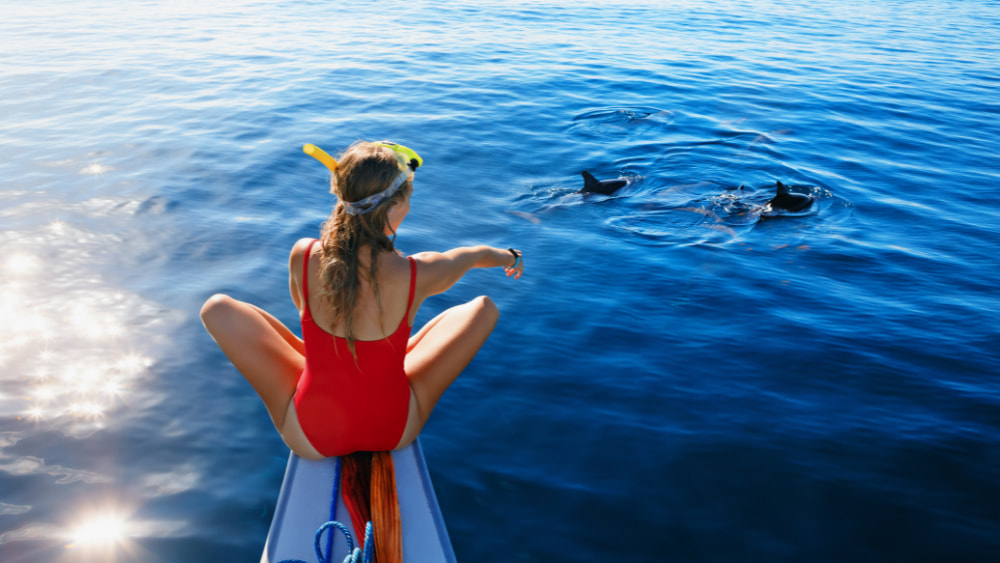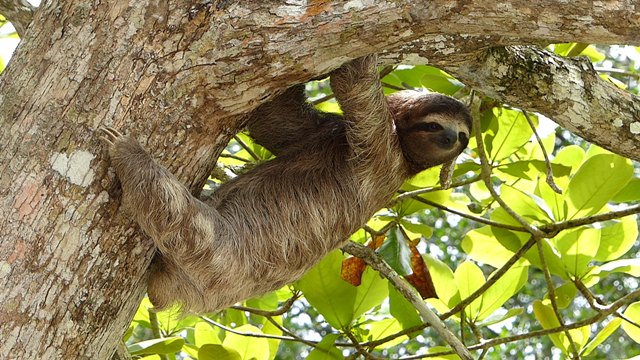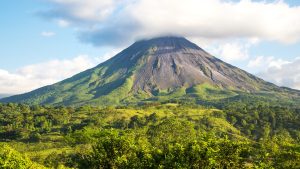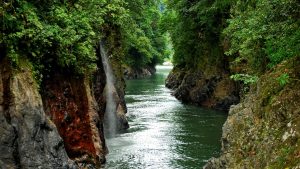Wildlife in Costa Rica
We decided to dedicate a whole article and create a Costa Rica Wildlife Calendar to help you choose what time of the year to visit if you are looking to spot a specific animal.
Costa Rica hosts 5% of the world’s biodiversity, with nearly 30% of the country dedicated to national parks and wildlife reserves.
Some popular species you can spot in Costa Rica are the howler monkeys, scarlet macaws, blue morpho butterflies, three-toed sloths, and humpback whales. No need for binoculars here – Costa Rica’s wildlife is everywhere!
Costa Rica is full of diversity, you can spot animals almost everywhere and all year round, but there are some species you’ll need a little help to spot.
If you want to know exactly where and when to spot animals in Costa Rica, then I hope this article answers all of your questions.

Table of Contents
Humpback Whales
Humpback whales are the most common whales in Costa Rica because it has the longest humpback whale viewing season in the world. Both the Antarctica and Alaska humpback whales overlap for a period of time in Costa Rica during their migration.
The best time to see humpback whales in Costa Rica is from July to October in the South Pacific, and from December to April on the North Pacific coast.
The best destinations to spot whales in Costa Rica are Drake Bay, Marino Ballena National Park, Golfito and Puerto Jimenez (Golfo Dulce Bay).
If you really wish to spot whales, I suggest you read our Whale Watching in Costa Rica guide.
Dolphins

There are several different species of dolphin that you can encounter in Costa Rica, but the most common dolphins – and the most well known – are bottlenose dolphins.
The best place to see dolphins & whales in Costa Rica is the Golfo Dulce, but you can spot them almost everywhere on the country’s pacific coast.
Possibilities to spot dolphins on a dolphin tour in Costa Rica are incredibly high!
Usually ranging from six to twelve feet long and living for as much as fifty years, dolphins are considered to be very intelligent.
Inshore dolphins tend to live in groups of about 10.
a very cool fact about Costa Rica is that swimming with whales or dolphins is illegal, so you’ll find a lot of tours where you will be able to spot them in the wild and not in captivity.
Turtles
You can see sea turtles on both the Caribbean and Pacific, some turtles are present all year long.
- Olive Ridley, Hawksbill, Leatherback sea turtle and Pacific Green sea turtle: all year long
- Leatherback sea turtles: Feb to July
- Atlantic green sea turtles: June to Nov
The best time of year to see turtles in Costa Rica is the rainy season or July – December. This is when the mass gatherings are the most intense.
The best time to come see the turtles on shore is during Arribadas (synchronized mass gathering of turtles). It is appropriately named because during this period of time you can see up to ten thousands turtles coming to the beach to nest at once. They come 24/7, even during the day!
This happens in only a few places in the world, with 2 of them in Costa Rica: Ostional and Playa Naranjo for the Olive Ridley Sea Turtles.
Best places in Costa Rica to see sea turtles are:
- Las Baulas National Park: This national park was established in 1990 to protect turtles from poachers. You can see them on Playa Grande in Oct – May laying their eggs. You have to reserve in advance for a spot and it is for turtle viewing only.
- Tortuguero: This national park is in the Caribbean North. It is one of the most important endangered green turtle nesting sites in the Western Hemisphere. Turtles come here from the months of July to October to lay their eggs. In November, you can see babies hatching.
- Santa Rosa National Park: Naranjo and Nancite, two beaches in the park are very mportant for sea turtle nesting. It is difficult to visit this national park since the road is in extremely bad condition and is usually closed off in rainy season.
- Ostional Wildlife Refuge: This refuge is one of the most important places for turtles in Costa Rica, specifically the Olive Ridley turtle.
- Gulf of Papagayo: It is common during July – September to see turtles mating in the water. Mostly Olive Ridley sea turtles as they then nest in Playa Naranjo or Ostional.
- Caño Island: It is common to see turtles, particularly juveniles at Caño Island and you can snorkel with them.
- Osa Peninsula and Corcovado National Park: Many of the beaches are nesting sites for 3 species of turtles.
- Montezuma: The Atlantic Riley turtle lays their eggs on this beach. The local community does baby sea turtle releases in February.
- Gandoca Manzanillo Wildlife Refuge: Located on the south Caribbean coast. Leatherback turtles nest here from March – May.
- Playa Hermosa Wildlife Refuge: Although this is a popular surfing beach, it’s also part of the Playa Hermosa Wildlife Refuge. During rainy season, up to 40 turtles nest per night.
Sloths

Sloths are plentiful throughout Costa Rica but may be difficult to spot to the untrained eye. A professional naturalist guide can help point them out. As a general rule, the further south you go along the Pacific coast, the more likely you are to see wildlife as the concentrations are higher. The South Pacific and Osa Peninsula are prime wildlife watching destinations.
There are six sloth species in the world, and two types of sloths: two-toed sloths and three-toed sloths.
Two of the six sloth species live in Costa Rica:
- Hoffman’s Two-toed Sloth (Choloepus Hoffmanni): It’s nocturnal and much more difficult to find. If you do find them during the day, they’ll probably be napping.
- Brown-throated Sloth (Bradypus Variegatus):The most common three-toed sloth in the world is the diurnal Brown-throated sloth. They are a bit smaller in size than Hoffman’s sloth as they slightly more active.
The best time to spot Sloths in Costa Rica is all year long, but you may need a tour guide to spot them, depending on the destination in Costa Rica you’re visiting.
The best places in Costa Rica to see sloths are Manuel Antonio, Puerto Viejo, Tortuguero, Dominical, Uvita, La Fortuna and the Osa Peninsula. They are abundant in more humid areas since the forests are green all year long so they always have food.
However, they are not common in Guanacaste where it is very dry. If you are in Guanacaste/Puntarenas (Tamarindo/Coco/Samara/Montezuma/Santa Teresa) and want to see a sloth, you will need to travel to the rainforest or visit an animal sanctuary.
Animal rescue centers or sanctuaries where you can see sloths are Jaguar Rescue Center, Toucan Rescue Ranch and Diamante Eco Adventure Park.
Monkeys
Four different species of monkeys are in Costa Rica: White-face Capuchin monkeys, Howler monkeys, Squirrel monkeys and Spider monkeys.
The Osa Peninsula and Corcovado National Park is the only place where you can find all four species of monkeys.
Squirrel monkeys are only found in the southern part of Costa Rica such as Corcovado and Manuel Antonio National Park.
Howlers and white face monkeys can be seen all throughout Costa Rica. In particular, howlers are especially common in Guanacaste.
Spider monkeys are more common in the Osa Peninsula but can also be seen in Rincon de la Vieja National Park in Guanacaste.
Best time to see monkeys in Costa Rica is all year long.
If you want to spot monkeys in their natural habitat you should book a tour with a tourist guide that knows the area and will help you spot them on the trees.
Toucans

6 different species of toucans are found in the rain forests of Costa Rica. The Chestnut-mandibled toucan (a subspecies of the Black-mandible toucan) is the largest of the six, and all can be seen in the tropical and subtropical forests.
The best time to see Toucans in Costa Rica all year long, but best during rainy season when the fruits they like are in season. Sometimes you can see up to 10 or more toucans in one tree!
You can’t see all 6 toucans in one place in Costa Rica, but you can see up to 3 in one.
In Monteverde, you can see the Emerald Toucanet, Keel billed and Black Mandibled Toucan.
In Manuel Antonio and Osa Peninsula, you can see the Chestnut-mandibled toucan and Fiery Aracari.
In La Fortuna you can see the Black Mandibled, Keel-billed and the Collared Aracari.
It is very hard to see the Yellow-eared toucanet though.
Some other excellent places to see toucans in Costa Rica are Puerto Viejo, Tortuguero, Poas, Uvita, Boca Tapada, Osa Peninsula and Bijagua.




